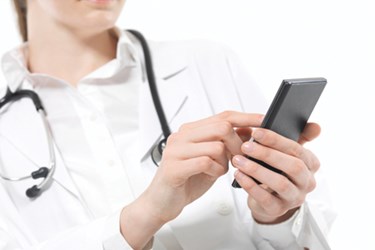New Optical Technique Could Turn Smartphones Into Diagnostic Devices
By Joel Lindsey

Researchers at University of Houston’s Cullen College of Engineering are developing a disease diagnostic system that could generate accurate readings using smartphones.
The project, led by assistant professor of electrical and computer engineering Jiming Bao and Huffington-Woestemeyer professor of chemical and biomolecular engineering Richard Willson, was described recently in the journal ACS Photonics.
“This new device, like essentially all diagnostic tools, relies on specific chemical interactions that form between something that causes a disease — a virus or bacteria, for example — and a molecule that bonds with that one thing only, like a disease-fighting antibody,” a detailed statement published on University of Houston’s website explained.
According to the statement, “The trick is finding a way to detect these chemical interactions quickly, cheaply and easily. The solution proposed by these professors involves a simple glass slide and a thin film of gold with thousands of holes poked in it. Creating this slide is itself an achievement.”
The process of constructing this specialized glass slide, devised primarily by Bao, began by coating the glass surface in a light-sensitive material known as a photoresist. A laser was then used to create a grid of tiny lines, called interference fringes, on the glass. This formed a “fishnet” pattern of UV exposure. Bao then developed and washed away this grid of exposed photoresist, leaving behind what looked like “pillars of photoresist.”
After coating the entire slide with a layer of evaporated gold, Bao used a technique called “lift-off” to wash away the pillars of photoresist along with the gold attached to them, producing a mostly gold-coated glass slide with rows and columns of transparent holes through which light could pass.
Once the slide had been created, Willson developed a chemical process for detecting the presence of bacteria or viruses.
In this process, the array of tiny holes is filled with disease antibodies, and a biological sample is washed over the slide. If the bacteria or virus being targeted is present in the biological sample, it reacts with the antibodies and essentially clogs up the hole. A second layer of antibodies is then applied, this time carrying special enzymes that create silver when exposed to the bacteria or virus trapped in the holes of the grid. At this point, any hole where a bacteria or virus is present becomes fully opaque, as light is blocked by the newly-created silver.
All a doctor would need to do in order to tell whether or not a bacteria or virus is present in the biological sample being tested is see if any holes of the grid have been blocked.
“A basic microscope used in elementary school classrooms provides enough light and enough magnification to show whether holes are blocked,” Willson said on UH’s website. “With a few small tweaks, a similar reading could almost certainly be made with a phone’s camera, flash and an attachable lens.”
Doing so would represent a significant decrease in the cost of disease diagnostic equipment, helping to make such technology more widely available.
“Some of the more advanced diagnostic systems need $200,000 worth of instrumentation to read the results. With this, you can add $20 to a phone you already have and you’re done,” said Willson.
“There are a lot of situations where an affordable diagnostic tool that is simple to use and simple to interpret could be very useful,” Willson continued. “If both your disposables and your reader are cheap, that makes it a lot easier to extend your system out into the real world.”
